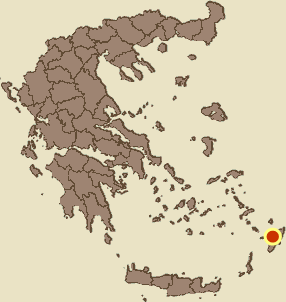Amartou monastery, Rhodes, Dodecanese,South Aegean
Tower of Amartos
| Location: |
| At the west corner of the yard of the Monastery of Amartou in Rhodes, 5km SW of Kritinia |
| Region > Prefecture: |  |
| South Aegean Dodecanese | |
| Municipality > Town: | |
| City of Rhodes • Amartou monastery | |
| Altitude: | |
|
Elevation ≈ 230 m (Relative Height≈0 m) |
| Time of Construction | Origin | |
| perhaps 14th century | IOANNITE |
|
| Castle Type | Condition | |
| Castle-Monastery |
In Ruins
|
Ruins of a late-medieval towerhouse beside the complex of the monastery Moni Panagia Amartou between the villages of Kritinia and Embonas in Rhodes..
Originally, the monastery was Catholic, dedicated to Saint Martha. The name “Amartou” probably comes from localization of the Santa Martha .
Castle Description
Text: Dr. Michael Losse – Singen (Hohentwiel), Germany (01.07.2021)General Description
In the middle of a fertile plateau lies the Monastery of Moni Panagia Amartou, founded in 1452 (cf. Gallas 1984, p. 290) and since long used as a farm.
To the west of it stands on a by road construction partly heavily cut terrain tongue the remains of a large late medieval tower.
It was interpreted as a possible lower nobility seat (of archontes) or "escape tower", since most authors did not perceive the Knights Hospitallers‘ coat of arms on the greyish-white marble escutcheon standing next to the church (cf. Losse 2009, p. 255). Presumably, the tower was built by the Hospitallers, a chivalric Order, as a watchtower or more likely by a member of the Order as a country estate, integrated into the watchtower's visual system as a vígla (cf. Losse 2009).
Part of the Chalki Channel and Alimia Island can be watched from here.
The approximately 1.5 m thick, formerly plastered inside and outside walls of the tower (10.82✖9.98 m) are made of roughly worked stones, some of which come as reading stones from a beach. Battlements are not (anymore) to recognize, but consoles of a box-machiculation are.
The tower‘s basement spanned a barrel vault, which supported the stone floor of the 1st floor, which has neither entrance nor window in the area of the preserved walls. The 2nd floor equipped with a wooden floor apparently opened up a high entrance on the south-side.
Access
Private, no sightseeing; from the all-round leading roadway easy to see. Free access to the church with the marble escutcheon (Knights Hospitallers‘ coat of arms) beside; please leave a donation in the sacrificial stick.
History of the castle
Unknown, but the marble escutcheon with the Knights Hospitallers‘ coat of arms suggests the construction of the tower in the time of the Orders‘ rule (1309-1522).
For the younger buildings of the monastery and the farm, stones have been removed from the tower as building material.
Surroundings: The region of Ámartos was settled in ancient times. To the south-southeast stands an ancient wall integrated in terraced fields on a hill within a sharp right turn to the right of the road. It perhaps belonged to a pyrgos or a fortified position.
Other Info
SourcesLock, Peter: Freestanding towers in the countryside of Rhodes. In: Elizabeth Jeffreys (Ed.): Byzantine Style, Religion and Civilization. In honour of Sir Steven Runciman. Cambridge 2006.
Losse, Michael: Wacht- und Wohntürme aus der Zeit des Johanniter-Ordens (1307-1522) auf der Ägäis-Insel Rhódos (Griechenland). In: Burgen und Schlösser 4, 2009, pp. 245-261, her p. 254-255.
Losse, Michael: Die Burgen und Festungen des Johanniter-Ritterordens auf Rhódos und in der Ägäis (Griechenland) 1307-1522. (Publisher: Nünnerich-Asmus Verlag) Mainz 2017.
Current Condition
Ruin, in danger of collapsing.
| First entry in Kastrologos: | January 2016 | Last update of info and text: | September 2021 | Last addition of photo/video: | September 2021 |
Sources
- Peter Lock, Freestanding towers in the countryside of Rhodes, in “Byzantine Style, Religion and Civilization: In Honour of Sir Steven Runciman”, CAMBRIDGE University Press, 2006
- Website ΟΔΥΣΣΕΥΣ - Greek Ministry of Culture Πύργος Αμάρτου
- All photos (June 2007) and article by Dr. Michael Losse
|
|
| Access |
|---|
| Entrance: |
| Private, no sightseeing; from the all-round leading roadway easy to see. Free access to the church with the marble escutcheon (Knights Hospitallers‘ coat of arms) beside; please leave a donation in the sacrificial stick. |



